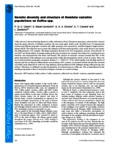Por favor, use este identificador para citar o enlazar este ítem:
http://www.alice.cnptia.embrapa.br/alice/handle/doc/1041410Registro completo de metadatos
| Campo DC | Valor | Lengua/Idioma |
|---|---|---|
| dc.contributor.author | CABRAL, P. G. C. | pt_BR |
| dc.contributor.author | MACIEL-ZAMBOLIM, E. | pt_BR |
| dc.contributor.author | OLIVEIRA, S. A. S. de | pt_BR |
| dc.contributor.author | CAIXETA, E. T. | pt_BR |
| dc.contributor.author | ZAMBOLIM, L. | pt_BR |
| dc.date.accessioned | 2016-03-18T11:11:11Z | pt_BR |
| dc.date.available | 2016-03-18T11:11:11Z | pt_BR |
| dc.date.created | 2016-03-18 | pt_BR |
| dc.date.issued | 2016 | pt_BR |
| dc.identifier.citation | Plant Pathology, v. 65, n. 2, p.196-204, Feb, 2016. | pt_BR |
| dc.identifier.uri | http://www.alice.cnptia.embrapa.br/alice/handle/doc/1041410 | pt_BR |
| dc.description | Coffee leaf rust is the most limiting disease for coffee cultivation in Brazil. Despite its importance, relatively little is known about the genetic diversity of Hemileia vastatrix, the rust causal agent. In this work, the DNA from 112 monopustule isolates from different geographic locations and coffee genotypes were analysed by amplified fragment length polymorphisms (AFLP). The objectives were to assess the influence of the host and geographic origin on the diversity and population differentiation in H. vastatrix. The fungal population showed a low level of genotypic diversity. Gene diversity (h) was 0027 and the hypothesis of random mating in the total population was rejected, but evidence for recombination was found for two subpopulations (São Paulo and Parana). The analysis of molecular variance revealed that 90% of the genetic distribution of the pathogen occurs among isolates within the subpopulation (states or host of origin). There was no correlation between geographic and genetic distance (r = 0024, P = 074), which together with the high number of migrants and the low degree of differentiation in populations of H. vastatrix, is consistent with the fact that the inoculum is probably easily dispersed by wind over long distances, allowing dispersal of the pathogen among coffee growing areas in Brazil. Therefore, it is difficult to predict the durability of resistant sources to coffee rust. The recommendation for the breeding programmes is thus to incorporate multigenic resistance as a control strategy. | pt_BR |
| dc.language.iso | eng | eng |
| dc.rights | openAccess | eng |
| dc.title | Genetic diversity and structure of Hemileia vastatrix populations on Coffea spp. | pt_BR |
| dc.type | Artigo de periódico | pt_BR |
| dc.date.updated | 2016-03-18T11:11:11Z | pt_BR |
| dc.subject.thesagro | Café | pt_BR |
| dc.subject.thesagro | Variação genética | pt_BR |
| dc.subject.nalthesaurus | Coffea | pt_BR |
| riaa.ainfo.id | 1041410 | pt_BR |
| riaa.ainfo.lastupdate | 2016-03-18 | pt_BR |
| dc.identifier.doi | 10.1111/ppa.12411 | pt_BR |
| dc.contributor.institution | P. G. C. CABRAL, UFV; E. MACIEL-ZAMBOLIM, UFV; SAULO ALVES SANTOS DE OLIVEIRA, CNPMF; EVELINE TEIXEIRA CAIXETA, SAPC; L. ZAMBOLIM, UFV. | pt_BR |
| Aparece en las colecciones: | Artigo em anais de congresso (SAPC)  | |
Ficheros en este ítem:
| Fichero | Descripción | Tamaño | Formato | |
|---|---|---|---|---|
| Geneticdiversity.pdf | 211.58 kB | Adobe PDF |  Visualizar/Abrir |









